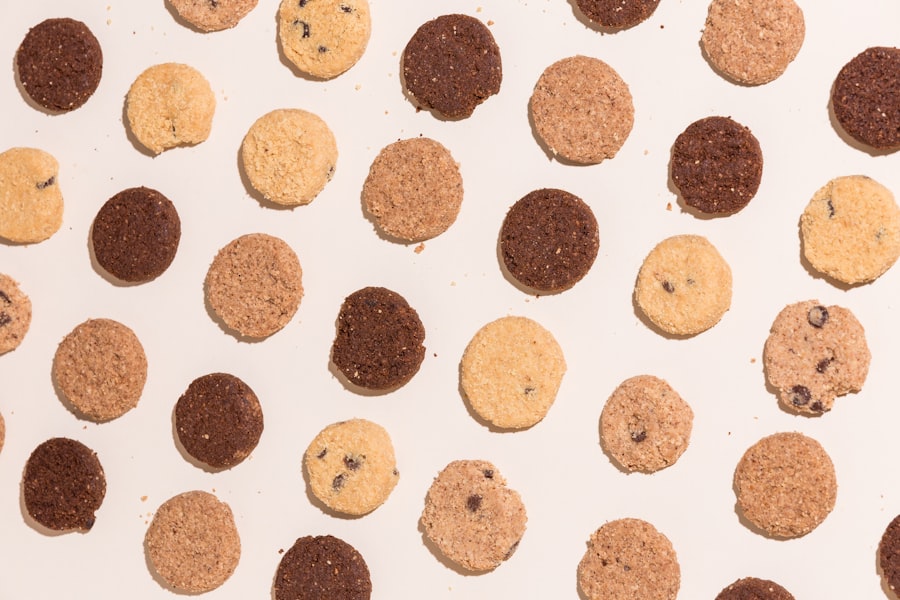The foundation of any successful cookie lies in the quality and selection of its ingredients. Flour, sugar, butter, eggs, and leavening agents are the primary components that contribute to the texture and flavor of cookies. When it comes to flour, all-purpose flour is a common choice due to its versatility, but for specific cookie types, such as chewy chocolate chip cookies, using bread flour can enhance the chewiness due to its higher protein content.
Conversely, cake flour, with its lower protein content, can yield a more tender cookie. Understanding the role of each type of flour can significantly impact the final product. Sugar is another critical ingredient that not only sweetens but also affects the texture and spread of cookies.
Granulated sugar creates a crispier texture, while brown sugar adds moisture and a rich flavor due to its molasses content. For those looking to experiment, using a combination of sugars can yield a delightful balance between crispness and chewiness. Additionally, the choice of butter—whether unsalted or salted—can influence the overall taste.
Unsalted butter allows for better control over the salt content in the recipe, while salted butter can add an unexpected depth of flavor. The freshness of these ingredients is equally important; using fresh eggs and high-quality butter can elevate the taste and texture of your cookies.
Key Takeaways
- Use high-quality ingredients for the best results in cookie baking
- Understanding the science of baking helps in achieving the perfect texture and flavor
- Proper mixing and shaping techniques are essential for uniform and attractive cookies
- Baking time and temperature greatly impact the final outcome of the cookies
- Troubleshoot common baking issues such as spreading or burning for better results
Understanding the Science of Baking
The Role of Heat and Leavening Agents
When cookies are baked, heat causes the fat to melt, creating a tender texture. As the dough heats up, leavening agents like baking soda or baking powder produce carbon dioxide gas, causing the cookies to rise. This reaction is crucial for achieving the desired texture; too little leavening can result in dense cookies, while too much can cause them to spread excessively.
The Maillard Reaction: Browning and Flavor Development
Another important aspect of baking science is the Maillard reaction, which occurs when proteins and sugars react under heat, leading to browning and the development of complex flavors. This reaction gives cookies their appealing golden-brown color and rich taste.
Temperature Control and Manipulating Variables
The temperature at which cookies are baked also plays a significant role in this process; higher temperatures can lead to quicker browning but may also result in a dry texture if not monitored closely. Understanding these scientific principles allows bakers to manipulate variables such as ingredient ratios and baking times to achieve their desired cookie characteristics.
Tips for Mixing and Shaping the Dough

The mixing process is crucial in determining the final texture of cookies. Overmixing can lead to tough cookies due to gluten development, while undermixing may result in uneven distribution of ingredients. A common technique is to cream together the butter and sugars until light and fluffy before gradually adding in the eggs and dry ingredients.
This method incorporates air into the dough, contributing to a lighter texture.
It’s also essential to mix just until combined when adding flour; this helps prevent overdevelopment of gluten.
Shaping the dough is another critical step that can influence both appearance and texture.
For uniform cookies, using a cookie scoop or measuring spoon ensures consistent sizes, which promotes even baking. Additionally, chilling the dough before baking can help control spread; colder dough will hold its shape better during baking. For those looking to add a decorative touch, rolling out dough and using cookie cutters can create fun shapes, while hand-rolling into balls can yield rustic-looking cookies.
Experimenting with different shapes and sizes can lead to unique presentations that enhance the overall cookie experience.
The Importance of Baking Time and Temperature
| Temperature | Baking Time | Result |
|---|---|---|
| 325°F | 25 minutes | Perfectly golden brown |
| 350°F | 20 minutes | Slightly overdone |
| 300°F | 30 minutes | Undercooked |
Baking time and temperature are pivotal factors that can make or break a batch of cookies. Each recipe typically provides a recommended baking time, but it’s essential to remember that ovens can vary significantly in temperature accuracy. Investing in an oven thermometer can help ensure that your oven is calibrated correctly, allowing for more consistent results.
Generally, cookies should be baked until they are set around the edges but still slightly soft in the center; they will continue to cook on the baking sheet after being removed from the oven. The type of cookie also dictates optimal baking conditions. For instance, delicate cookies like meringues require lower temperatures for longer periods to dry out without browning, while thicker cookies may need higher temperatures for a shorter time to achieve a crisp exterior with a chewy interior.
Adjusting baking times based on cookie size is also crucial; larger cookies will naturally require more time than smaller ones. Keeping a close eye on your cookies as they bake will help you achieve that perfect golden-brown finish without overbaking.
Troubleshooting Common Cookie Baking Issues
Even experienced bakers encounter challenges when it comes to cookie baking. One common issue is cookies spreading too much during baking, which can be caused by several factors including warm dough or insufficient flour. To combat this, ensure that your butter is at room temperature but not overly soft; chilling the dough for at least 30 minutes before baking can also help maintain shape.
If your cookies are turning out too dry or crumbly, it may be due to too much flour or not enough fat; measuring flour accurately by spooning it into a measuring cup rather than scooping directly from the bag can prevent this problem. Another frequent problem is uneven baking, where some cookies are perfectly baked while others are underdone or burnt. This inconsistency often arises from overcrowding the baking sheet or placing it on an uneven rack in the oven.
To promote even baking, leave adequate space between each cookie on the sheet and consider rotating your baking sheets halfway through the baking time. If you find that your cookies are consistently burnt on the bottom, it may be worth investing in insulated baking sheets or parchment paper to help distribute heat more evenly.
Decorating and Presentation

Icing Options
Icing is a popular method for adding both flavor and visual interest to cookies. Royal icing provides a smooth finish ideal for intricate designs, while buttercream offers a richer taste and texture.
Simple yet Elegant Decorating Ideas
For those looking for simplicity, dusting cookies with powdered sugar or drizzling melted chocolate can create an elegant presentation without requiring extensive decorating skills.
Adding Texture and Color with Toppings
Incorporating toppings such as sprinkles, nuts, or coconut flakes can add texture and color to your cookies. For example, rolling cookie dough balls in coarse sugar before baking creates a delightful crunch on the exterior.
Presentation Ideas
When presenting cookies for special occasions, consider arranging them on decorative platters or stacking them in clear jars tied with ribbons for an inviting display. The visual appeal of your cookies can enhance their enjoyment and make them more enticing for guests.
Storing and Packaging for Freshness
Proper storage is essential for maintaining the freshness and quality of baked cookies. To keep cookies soft and chewy, store them in an airtight container at room temperature; adding a slice of bread or a few marshmallows can help retain moisture over time. For crisp cookies, such as biscotti or gingersnaps, storing them in a container with a loose lid allows air circulation while preventing them from becoming stale.
When it comes to packaging cookies for gifts or events, presentation matters just as much as freshness. Wrapping cookies in cellophane bags tied with twine or placing them in decorative boxes lined with tissue paper adds a personal touch that makes them feel special. For longer storage options, freezing cookies is an excellent way to preserve their quality; simply place them in an airtight container or freezer bag with layers of parchment paper between them to prevent sticking.
Thawing them at room temperature before serving ensures they taste freshly baked.
Variations and Creative Recipes
The world of cookie baking is vast and filled with opportunities for creativity and experimentation. Classic recipes like chocolate chip or oatmeal raisin serve as excellent bases for variations; adding different mix-ins such as nuts, dried fruits, or flavored extracts can transform these staples into something unique. For instance, swapping out semi-sweet chocolate chips for white chocolate or butterscotch chips introduces new flavors that can surprise even seasoned cookie lovers.
Exploring international cookie recipes can also broaden your baking repertoire. Italian biscotti offers a crunchy texture perfect for dipping into coffee or tea, while French macarons provide a delicate meringue-based treat filled with ganache or fruit preserves. Vegan or gluten-free adaptations of traditional recipes allow bakers with dietary restrictions to enjoy delicious treats without compromising on flavor or texture.
By experimenting with various ingredients and techniques, bakers can create an endless array of cookie variations that cater to diverse tastes and preferences.
Cookie, a beloved family pet, has been shown to have a positive impact on mental health and well-being. According to a recent study highlighted in this article, owning a pet like Cookie can help reduce stress and anxiety levels. The study also found that interacting with animals can improve mood and increase feelings of happiness. So, not only is Cookie a loyal companion, but she also plays a crucial role in promoting emotional wellness.





















+ There are no comments
Add yours